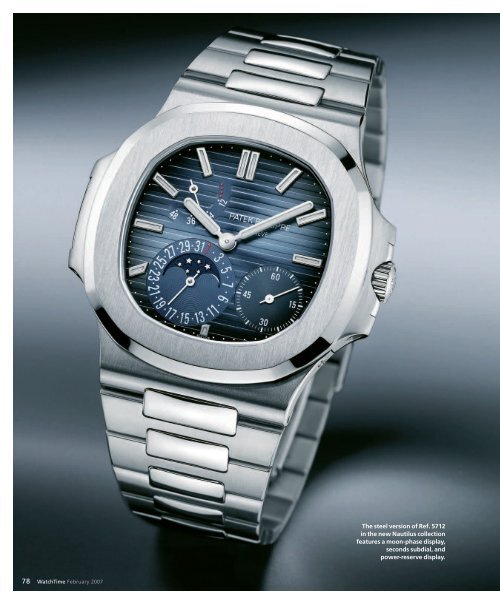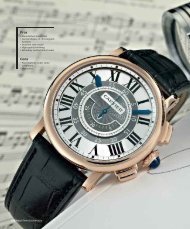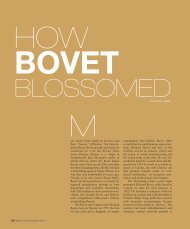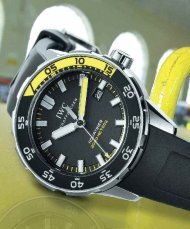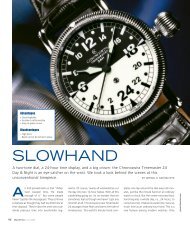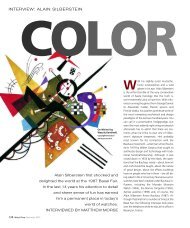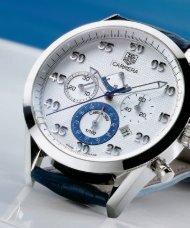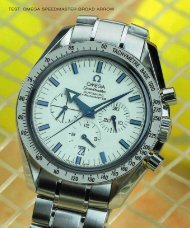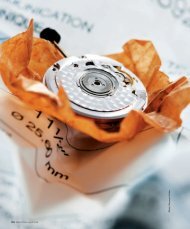WT_2007_01: PATEK PHILIPPE NAUTILUS
WT_2007_01: PATEK PHILIPPE NAUTILUS
WT_2007_01: PATEK PHILIPPE NAUTILUS
- No tags were found...
Create successful ePaper yourself
Turn your PDF publications into a flip-book with our unique Google optimized e-Paper software.
78 WatchTime February <strong>2007</strong><br />
The steel version of Ref. 5712<br />
in the new Nautilus collection<br />
features a moon-phase display,<br />
seconds subdial, and<br />
power-reserve display.
<strong>NAUTILUS</strong>:<br />
THE NEXT<br />
GENERATION<br />
Patek Philippe unveils new versions of its sporty old classic.<br />
BY NORMA BUCHANAN<br />
What watch are you wearing If it’s<br />
big, sporty, steel and costs more<br />
than your friends or family can<br />
countenance, it traces its lineage back to the<br />
1970s. That’s when a cadre of extraordinarily<br />
expensive (for the time), bulky, steel sports<br />
watches hit the market, forever wiping out the<br />
notion that luxury watches had to be dressy, refined,<br />
and made of precious metal.<br />
Patek Philippe’s Nautilus was one of these<br />
renegades. It surprised consumers, even<br />
shocked them, says Patek Philippe’s CEO Philippe<br />
Stern, because a sporty steel Patek was<br />
then seen as a contradiction in terms.<br />
That was then. The Nautilus, as every watch<br />
fan knows, is now a venerated classic, and<br />
holds a permanent seat on the famous-sportswatch<br />
dais with other models like the Audemars<br />
Piguet Royal Oak (which, along with<br />
Vacheron Constantin’s 222, was in the ‘70s<br />
vanguard of steel luxury sports watches), the<br />
Rolex Oyster, and the Omega Seamaster.<br />
In November, to mark the watch’s 30th<br />
birthday, Patek Philippe introduced a revamped<br />
Nautilus collection. It contains the first<br />
Nautilus chronograph, plus a new version of<br />
the “Jumbo,” the favorite of collectors. There<br />
are also updated renditions of the 3712, the<br />
moon-phase Nautilus that debuted in 2005,<br />
including the first rose-gold Nautilus in regular<br />
production. (There was at least one prior rosegold<br />
Nautilus; it was made in a limited series in<br />
1981 for the Italian market.)<br />
The new models measure about 1 mm<br />
wider than the old ones, not because the case<br />
has expanded but because its sides, the socalled<br />
“ears,” are more rounded and hence<br />
project outward more. In addition, all but one<br />
of the new models have cases composed of<br />
three parts instead of the traditional two.<br />
They’re also more expensive, with list prices<br />
five to 10 percent higher than for their predecessors.<br />
Prices range from $16,400 to<br />
$32,800. The latter price is for the new steel<br />
The original 1976 Nautilus, Ref. 3700, was 42<br />
mm wide and affectionately called the Jumbo.<br />
February <strong>2007</strong> WatchTime 79
<strong>PATEK</strong> <strong>PHILIPPE</strong> <strong>NAUTILUS</strong><br />
quartz watches. A huge steel watch at a huge<br />
price was one way to capture headlines. “The<br />
Nautilus was a response to the quartz crisis,”<br />
says Philippe Stern. “Quartz watches started<br />
around 1970 to 1972, and we had to react. We<br />
started to make new types of mechanical<br />
watches, including [not just the Nautilus] but<br />
very thin automatic movements like the 240,<br />
which we are still using today. We wanted to<br />
continue to make the mechanical watch interesting<br />
for our customers.”<br />
At the same time, consumers were becoming<br />
more involved in sports and more inclined<br />
to dress down rather than up. The jogging<br />
craze was taking off, along with a passion for<br />
outdoor pastimes, and the zeitgeist was ripe<br />
for sports watches, the company believed.<br />
The watch was designed by watch-styling<br />
superstar Gerald Genta (who also designed<br />
the Royal Oak). The original model, the 3700,<br />
was a gigantic 42 mm wide (it was later nicknamed<br />
“the Jumbo”) and had a bezel the<br />
company describes as “an octagon with gently<br />
rounded corners,” designed to look like the<br />
porthole of a ship. (Its maritime styling and impressive<br />
water-resistance — to 120 meters —<br />
An exploded view of Ref. 5711 shows its new three-part case. Previous<br />
Nautili had two-part cases.<br />
chronograph: steel-watch sticker shock is now<br />
as quaint as shag haircuts and leisure suits. All<br />
the new models have sapphire casebacks.<br />
Despite the changes, though, the look is still<br />
unmistakably Nautilus. Tinkering with a wellestablished<br />
design is dangerous, says Thierry<br />
Stern, who is Patek’s vice president and the son<br />
of Philippe Stern. That’s why the company left<br />
the collection’s basics untouched.<br />
That ‘70s Watch<br />
In a few ways, those basics — the unusually<br />
shaped steel case, hefty dimensions and sporty<br />
styling — were a response to the era in which<br />
the watch was launched, Philippe Stern says.<br />
In 1976, the Swiss industry was in the midst<br />
of the quartz crisis, a debacle that would cut its<br />
watch-industry employment by two-thirds, to<br />
30,000 people; shut countless watch factories;<br />
and make Japanese and Hong Kong companies,<br />
and, for a short time, American ones,<br />
kings of the watch world.<br />
Switzerland’s mechanical-watch makers<br />
put up a fight against the quartz-watch onslaught.<br />
Their strategy was to bring out unusual-looking<br />
or technically advanced mechanical<br />
watches that could snatch some thunder from<br />
DATA<br />
<strong>PATEK</strong> <strong>PHILIPPE</strong> <strong>NAUTILUS</strong><br />
Model: Reference 5711/1A<br />
Functions: Hours, minutes, seconds, date<br />
Movement: Caliber 315 SC; automatic; center<br />
rotor in 21k gold; unidirectional winding; Gyro<br />
max balance; flat balance spring; 21,600 vph;<br />
diameter = 27 mm; height = 3.22 mm, 213<br />
components; 29 jewels; power reserve 38 to 48<br />
hours; Geneva Seal<br />
Case: Stainless steel; three-part (back, caseband,<br />
bezel); sapphire caseback; screw-down<br />
crown; water-resistant to 120 meters; bezel<br />
with vertical satin finish; width = 44.02 mm<br />
(including ears and crown); length = 38 mm<br />
(bezel); height = 8.3 mm<br />
Dial: Gradation from dark blue in the middle<br />
to black at the periphery; horizontal-stripe embossed<br />
pattern; 12 applied baton hour markers<br />
in 18k white gold with luminous coating;<br />
baton-style hour and minute hands in 18k<br />
white gold with luminous coating; white-gold<br />
seconds hand<br />
Bracelet and clasp: Stainless steel bracelet;<br />
middle links polished; outer links satin-finished;<br />
stainless steel fold-over clasp<br />
Price: $17,300<br />
80 WatchTime February <strong>2007</strong>
The new Jumbo, like all the models<br />
in the new collection, has sapphire<br />
crystals on the front and back.<br />
February <strong>2007</strong> WatchTime 81
<strong>PATEK</strong> <strong>PHILIPPE</strong> <strong>NAUTILUS</strong><br />
“The Nautilus was a response to the quartz crisis. We started<br />
to make new types of mechanical watches. We wanted to<br />
make the mechanical watch interesting for our customers.”<br />
<strong>PATEK</strong> <strong>PHILIPPE</strong> CEO <strong>PHILIPPE</strong> STERN<br />
Thierry (left) and Philippe Stern<br />
A 1970s ad for the original Nautilus<br />
were the source of its name.) It contained the<br />
self-winding caliber 28-255 C, which used a<br />
Jaeger-LeCoultre 920 base. The dial was as<br />
simple as could be: the hour indices were<br />
straight lines that matched the baton shape of<br />
the hour and minute hand (there was no seconds<br />
hand). The face’s only embellishment<br />
was a date window at 3 o’clock.<br />
The case, a fairly slim 7.6 mm thick (the<br />
movement was just 3.05 mm thick), was<br />
made of two pieces rather than the usual<br />
three. The watch’s most unusual feature was<br />
the two ears on either side of the case. Philippe<br />
Stern, who helped design the watch and<br />
whose name appears on the patent (he became<br />
the company’s CEO the year after it was<br />
launched) says the ears, also referred to as<br />
“hinges,” were initially meant to be just that,<br />
allowing the case to be opened like a door<br />
from one side. That idea proved impracticable<br />
because it endangered the dial, and the company<br />
chose instead to fasten the case with<br />
four little screws projecting laterally into the<br />
ears.<br />
Most notable of all was the watch’s price:<br />
$2,350. It could have been a serious liability,<br />
but Patek turned it into an asset by shining a<br />
spotlight on it. Print advertisements declared,<br />
“One of the world’s costliest watches is made<br />
of steel.”<br />
At first the watch received mixed reviews,<br />
Philippe Stern recalls. Some saw its base-metal<br />
case as a scar on Patek’s golden image. “At<br />
the launch, some people didn’t think<br />
we should make a steel watch, but<br />
that we should only make gold,”<br />
Stern says.<br />
Others objected to its<br />
price. “People thought<br />
that if a watch were<br />
expensive it would<br />
have to be in<br />
gold,” he<br />
DATA<br />
<strong>PATEK</strong> <strong>PHILIPPE</strong> <strong>NAUTILUS</strong><br />
Model: Reference 5800/1A<br />
Functions: Hours, minutes, sweep seconds,<br />
date<br />
Movement: Caliber 330 SC; automatic; central<br />
rotor in 21k gold; unidirectional winding;<br />
four-arm Gyromax balance with four inertia<br />
blocks; flat balance spring; 21,600 vph; diameter<br />
= 27 mm; height = 3.5 mm; 217 components;<br />
29 jewels; power reserve of 38 to 48<br />
hours; Geneva Seal<br />
Case: Stainless steel; two part (monocoque and<br />
bezel); sapphire case-back; water-resistant<br />
crown with split stem; bezel with vertical satin<br />
finish; water-resistant to 120 meters; width =<br />
39.80 mm (including ears and crown); length =<br />
33.20 mm (bezel); height = 7.85 mm<br />
Dial: Gradation from dark blue in the middle<br />
to black at the periphery; horizontal embossed<br />
pattern; 12 applied baton hour markers in 18k<br />
white gold with luminous coating; baton-style<br />
hour and minute hands in 18k white gold with<br />
luminous coating; white-gold seconds hand<br />
Bracelet: Stainless steel, middle links polished,<br />
outer links satin-finished, stainless steel fold-over<br />
clasp<br />
Price: $16,400<br />
says. Audemars Piguet had launched its steel<br />
Royal Oak four years earlier, at the then-crazy<br />
price of about $2,200, but the notion of a luxury<br />
steel watch still met with resistance from<br />
many consumers.<br />
A side view of the new<br />
mid-sized Nautilus, Ref. 5800,<br />
reveals its surprisingly thin profile<br />
82 WatchTime February <strong>2007</strong>
<strong>PATEK</strong> <strong>PHILIPPE</strong> <strong>NAUTILUS</strong><br />
DATA<br />
<strong>PATEK</strong> <strong>PHILIPPE</strong> <strong>NAUTILUS</strong><br />
Model: Reference 5712/1A, 5712W,<br />
5712R<br />
Functions: Hours, minutes, seconds, power-reserve<br />
indication, date, moon-phase<br />
Movement: Caliber 240 PS IRM C LU; ultrathin<br />
automatic; integrated minirotor in 22k<br />
gold; unidirectional winding; Gyromax balance;<br />
flat balance spring; 21,600 vph; diameter = 31<br />
mm; height = 3.98 mm; 265 components; 29<br />
jewels; power reserve 38 to 48 hours; Geneva<br />
Seal<br />
Case: Stainless steel, white gold or rose gold;<br />
three-part (back, case-band, bezel); sapphire<br />
caseback; water-resistant to 60 meters; bezel<br />
with vertical satin finish; width (including ears<br />
and crown) = 44.05 mm; length = 38 mm (bezel);<br />
height = 8.52 mm<br />
Dial: Steel model: gradation from dark blue in<br />
middle to black at periphery. White-gold model:<br />
charcoal. Rose-gold model: gradation from<br />
dark brown in middle to black at periphery. All<br />
dials have horizontal-stripe embossed pattern<br />
and gold, applied baton hour markers and baton<br />
hands.<br />
Bracelet and clasp: Steel model has steel<br />
bracelet with middle links polished, outer links<br />
satin-finished and steel fold-over clasp. Gold<br />
models have alligator straps (black for the whitegold<br />
model and brown for the rose-gold one)<br />
and a three-part safety fold-over clasp in 18k<br />
white or rose gold.<br />
Price: Stainless steel: $21,900; white or rose<br />
gold: $27,600<br />
Ref. 5712 comes in a white-gold and<br />
a rose-gold case.<br />
But the watch did have its fans, those who<br />
saw it as refreshingly unorthodox and, at the<br />
same time, practical. “People had started to<br />
realize that times were changing and it was<br />
time to wear something new and different on<br />
their wrists,” says Philippe Stern.<br />
Its high level of water resistance and<br />
knockabout styling made it perfect for weekend<br />
wear, but it also fit in at the office. Its<br />
launch advertisement described its versatility<br />
thus: “Nautilus. . .will accompany you when<br />
you dive. Or when the occasion is formal or<br />
festive. Or when you set out to slay dragons<br />
in the boardroom.” (The dragon reference<br />
was an allusion to the ad’s earlier comparison<br />
of the watch to a sword. Both, the ad copy explained,<br />
“took shape between the skilled<br />
hands of master craftsmen.”) For those who<br />
found steel just too sporty for party wear, the<br />
watch also came in gold, gold and steel, and<br />
even platinum models, and styles with diamond-studded<br />
dials.<br />
By the 1980s the watch had proved its staying<br />
power. In 1981, Patek launched a 37.5-mm<br />
model, the 3800, which contained Patek’s inhouse<br />
caliber 330 SC, with sweep seconds<br />
hand, and a smaller women’s Nautilus, the<br />
4700, with caliber E19 C.<br />
In 1998, due to high demand, especially<br />
from Italian watch collectors, the large-size<br />
Nautilus was resurrected in reference 3710/1A.<br />
It had been discontinued eight years earlier.<br />
The new model contained Caliber 330 SC IZR<br />
and bore Roman numerals and an unusual<br />
power-reserve indicator (the “IZR” in the caliber<br />
name) on its dial. That display made use of<br />
a rotating hand and disk, the latter bearing a<br />
comet-shaped piece of metal, earning it the<br />
nickname “the comet.”<br />
In 2005, the company introduced what was<br />
its most complicated Nautilus up to that time, a<br />
model with date and moon-phase in a subdial<br />
84 WatchTime February <strong>2007</strong>
<strong>PATEK</strong> <strong>PHILIPPE</strong> <strong>NAUTILUS</strong><br />
at 7 o’clock, a small seconds subdial at 4 o’-<br />
clock, and a power reserve indicator at 11 o’-<br />
clock (not the comet, but a more traditionallooking<br />
one). Its movement, the 240 LU, was<br />
based on Patek’s very thin (just 2.40 mm), wellknown<br />
240 movement, one of the thinnest automatic<br />
movements ever made. This model,<br />
reference 3712, now discontinued, has become<br />
a red-hot item on the secondary market<br />
in large part because it was in production for<br />
such a short time.<br />
From Jumbo to Chrono<br />
Patek Philippe unveiled the new Nautilus collection<br />
in October in Geneva, at a cocktail party-cum-fashion<br />
show at the Palladium discotheque,<br />
featuring sartorial hits from (when<br />
else) the ‘70s. Pieces from the new collection<br />
began hitting stores almost immediately, although<br />
many potential buyers have joined<br />
arm-long waiting lists, just as a major new advertising<br />
campaign for the watch began. The<br />
collection consists of six pieces.<br />
The first is the updated Jumbo. Fans of the<br />
watch will be happy to see that their old favorite<br />
is much the same as before, except that<br />
it has lost its Roman numerals and comet-style<br />
power-reserve indicator (which, according to<br />
one Patek executive, proved difficult to read)<br />
and hence looks more like the original 3700.<br />
The new Jumbo, reference 5711/1A, priced at<br />
$17,300, lives up to its name with a case measuring<br />
44.02 mm from the end of the left ear<br />
to the tip of the crown. It’s available only in<br />
steel. The case is made of three parts instead<br />
of two, as the original was. Like all the new<br />
models, this one has a transparent sapphire<br />
back, offering a view of the automatic caliber<br />
315 SC. Nautilus aficionados will note some<br />
subtle styling changes in the 5711 common to<br />
all the new models. Among them is a “less aggressive”<br />
shape, as Thierry Stern describes it,<br />
thanks to the case’s more gently rounded ears.<br />
Also, the hands and hour markers are larger,<br />
and the outer tips of the latter are angled so<br />
that they perfectly follow the inner curve of<br />
the bezel.<br />
There’s a new mid-sized version, too, the<br />
5800/1. This model, which replaces the 3800,<br />
is 39.80 mm in diameter. Like its big brother, it<br />
comes only in steel. Alone among the new<br />
models, it retains the Nautilus’s traditional<br />
“monocoque,” or two-part (case and bezel)<br />
THREE DECADES<br />
OF THE <strong>NAUTILUS</strong><br />
1976: The so-called “Jumbo,” 42 mm in diameter,<br />
reference 3700/1A. Discontinued in<br />
1990.<br />
1981: The medium-sized 3800/1A, 37.5 mm<br />
in diameter, with in-house Patek Caliber<br />
330. Discontinued in 2006.<br />
1998: The new Jumbo with “comet” power<br />
reserve indicator (called the IZR), reference<br />
3710/1A. Discontinued in 2006.<br />
2004: A white-gold version of the Jumbo,<br />
3711/1A. Discontinued in 2006.<br />
2005: The moon-phase Nautilus, 3712/1A.<br />
Discontinued in 2006.<br />
Exploded view of the new Nautilus chronograph,<br />
Ref. 5980<br />
2006: The new collection, containing six<br />
pieces.<br />
86 WatchTime February <strong>2007</strong>
The new Patek Philippe Nautilus Ref. 5980<br />
construction. Like the 3800, it contains caliber<br />
330 SC. Its suggested retail price is $16,400.<br />
The collection also contains a new moonphase<br />
Nautilus, reference 5712, which replaces<br />
the 3712. The 5712, like its predecessor,<br />
has a calendar, moon-phase display and<br />
power reserve indicator. The real news here is<br />
addition of fairly dressy, white-gold and rosegold<br />
variations, each priced at $27,600, the<br />
only gold models in the new Nautilus group.<br />
Both come only on straps: black for the whitegold<br />
model and brown for the rose-gold. The<br />
white-gold model has a lacquered charcoal<br />
dial; the rose-gold one a brown-charcoal dial.<br />
The 5712 also comes in steel with steel<br />
bracelet at $21,900.<br />
Lastly, there’s the 5980/1A, the first Nautilus<br />
chronograph. If the subdial at 6 o’clock<br />
looks familiar, it’s because Patek uses the<br />
same caliber, the CH 28-520 in-house column-wheel<br />
chrono movement, in this watch<br />
as it does in the Annual Calendar Chronograph<br />
it launched last year (reference 5960P).<br />
DATA<br />
<strong>PATEK</strong> <strong>PHILIPPE</strong> <strong>NAUTILUS</strong><br />
Model: Reference 5980/1A<br />
Functions: Flyback chronograph; hours; minutes;<br />
seconds; date<br />
Movement: Caliber CH 28-520 C; automatic;<br />
column-wheel flyback chronograph; central rotor<br />
in 21k gold; unidirectional winding; oil-free ball<br />
bearing with zirconium balls; four-arm Gyromax<br />
balance with four inertia blocks; Breguet overcoil<br />
balance spring; 28,800 vph; diameter = 30 mm;<br />
height = 6.63 mm; 327 components; 35 jewels;<br />
power reserve 55 hours maximum; Geneva Seal<br />
Case: Stainless steel, three-part (back, caseband,<br />
bezel); sapphire caseback; screw-down<br />
crown; water-resistant to 120 meters; bezel<br />
with vertical satin finish; width = 45.60 mm<br />
(including ears and crown); length = 38.50 mm<br />
(bezel); height = 12.16 mm<br />
Dial: Sweep chronograph seconds hand;<br />
sub-dial at 6 o’clock with 60-minute counter<br />
(counts elapsed minutes on two concentric<br />
cir-cles from 0 to 30 and 30 to 60) and 12-hour<br />
counter. Center-mounted chrono seconds hand<br />
doubles as continuous seconds hand; quick action<br />
date at 3 o’clock (date changes in less than 1/10<br />
of a second); gradation from dark blue in middle<br />
to black at periphery; horizontal-stripe embossed<br />
pattern; baton-style hour and minute hands<br />
and nine applied baton hour markers in 18k<br />
white gold with luminous coating; sandblasted<br />
and rhodium-coated steel seconds hand; arrowshaped<br />
minute-counter hand with counter<br />
weight, tip coated with red lacquer<br />
Bracelet and clasp: Stainless steel; middle links<br />
polished; outer links satin-finished; steel foldover<br />
clasp<br />
Price: $32,800<br />
Unlike the 5960P, the new Nautilus has a<br />
standard, rather than annual, calendar, and<br />
no power- reserve display. It does feature the<br />
5960P’s most innovative feature: a chronograph<br />
hand that can also be used as a continuously<br />
running seconds hand. As with the<br />
5960P, the subdial at 6 o’clock is both a minutes<br />
and hours totalizer. The elapsed minutes<br />
are counted on two concentric scales from 0<br />
to 30 and 30 to 60, and the hours on a single<br />
1-to-12 scale. (For more on this movement<br />
and the 5980/1A, see the April 2006 issue of<br />
WatchTime.) The calendar, which is an improved<br />
version of a mechanism Patek patented<br />
in 1991, changes at midnight in just 1/10<br />
of a second.<br />
■<br />
February <strong>2007</strong> WatchTime 87


